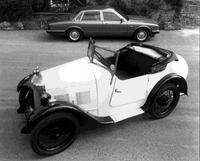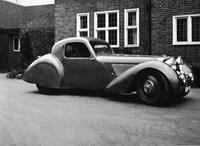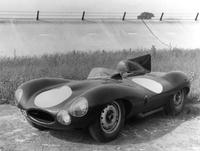Jaguar - A Brief Design History
By Carey Russ
Jaguars have always had a distinctive and immediately-recognizable style. And, while not inexpensive, they have always been much more reasonably-priced than other well-known premium automobiles. Maybe that is because of the company's origin as a custom coachbuilder in the 1920s. Even then, the products of the Swallow Sidecar company, as it was then known, were modestly-priced when compared to other bespoke bodies.
Swallow started out building motorcycle sidecars, which were used at the time by people who couldn't afford a car. When Swallow branched out to cars, their first products were custom bodies for the then recently-introduced Austin Seven. The Seven was designed as inexpensive transportation, and can be thought of as England's Model T. Regular people as well as the wealthy like a little exclusivity, and the Swallow Austins did well. But the car that put Swallow solidly into history was the Standard Swallow 1, soon knows as the SS1, a Swallow body on a Standard chassis. The first was introduced in 1931, and was a ``fixed head coupe'' (coupe with non-removable top) with classic long-hood, short deck, cab-rearward proportions. It was extremely low for its day, with the roof only four feet, seven inches off the ground. Convertible models followed. In 1936, the SS Jaguar 100, a fast sports car suitable for competition, debuted, and the Jaguar name was soon applied to many of the cars in the Swallow lineup.
Jaguar Cars, Ltd. was registered in late 1937, although SS Cars continued until 1945. The name change was fortuitous, given the connotations of the ``SS'' name during and after World War II. SS Jaguars before the war became Jaguars afterwards.
In 1938, an aerodynamically-styled prototype was built for the important Earl's Court auto show in London. With sweeping, semi-enclosed fenders and a small, rounded two-seat passenger cabin, it bore some resemblance to French designs of the day. It was a one-off that never saw production, but...
After the war, production resumed with Jaguar's series of sedans. However, during the war engine development had taken place when time and conditions allowed. Engineers will be engineers.... First was the XG, then the XF, then the XJ. And after hostilities ceased, the XK saw the light of day, in dual overhead cam, 3.5-liter, inline six-cylinder form in 1948. It went into a car known as the Jaguar XK120, a convertible with lines obviously derived from those of the 1938 Earl's Court car. At the first post-war Earl's Court show, it was a fantastic success. A fixed-head coupe debuted in 1951, with a more-than-passing resemblance to the 1938 concept car. With leather and wood trim and wind-up windows in an era of side curtains, it was a true high-performance luxury car.
On the road, the XK120 led to the larger, even more luxurious XK140, and then to the XK150. All had similar looks, although the 140 and 150 were increasingly more modern. All were raced in production classes, but weren't quite up to the standards of the fastest sports-racing cars of the day (read: Ferrari.) The XK engine was amenable to tuning - it had a long production life, surviving with modifications into the early 1990s - but the chassis and aerodynamics of the XK120 could use improvement for higher speeds. And so the XK120C was born, with lighter, more aerodynamic alloy body panels and a much different, stiffer frame. Its first race was the 1951 24 Hours of LeMans, which it won.
It was the beginning of a dynasty. The C-Type, as it was soon known, went into production, and was sold to all interested parties - for far less than the equivalent Ferraris.
Mercedes-Benz won at LeMans in 1952, with a prototype of the 300SL sports car, but Jaguar was back at the top in 1953, with a further-developed C-Type. It featured some of the earliest four-wheel disc brakes used in a racing car, and Jaguars finished first, second, and fourth.
1954 saw the debut of the D-Type. While it looked like a development of the C, and had a similar engine, it was radically different in construction. Most cars, including racing cars, in those days had frames separate from their bodies; the D-Type had a tubular subframe in front, holding the engine, transmission, and suspension, but the central and rear parts of the car were of aircraft-type stressed-skin monocoque construction, for superior rigidity and decreased weight. The D-Type finished second to a Ferrari in 1954, and then was dominant in 1955, 1956, and 1957. The `54 car had a faired headrest behind the driver for comfort and some aerodynamic advantage. This was modified in `55 and later with a large, high fin for aerodynamic stability on the high-speed Mulsanne Straight at LeMans. The D-Types were timed at over 175 mph. Ever wonder where the late 1950s vogue for tail fins on road began?
Customer models of the D-Type were made, and raced, but the market for pure racing cars has never been large, or particularly lucrative. A road-going version of the D-Type, called the XKSS, was to be built in 1957, to use unsold D-Type chassis. A factory fire in February of that year destroyed any chance the XKSS had for production. Only 16 were built.
But the spirit of the D-Type and XKSS lived on. The XK-series sports cars were, even at that time, as dated in their chassis construction as the D was futuristic. In 1957, a prototype was constructed that was to have a major effect on automotive history. E1A looked, and was built, much like a smoother, more lithe D-Type. Where the D had a solid rear axle, E1A used an innovative independent rear suspension in which the halfshafts served double duty as the top suspension links. Like the later Ds, it used four-wheel disc brakes.
The aluminum alloy E1A begat the steel-bodied E2A in 1959, which had an even leaner look. Underneath, it was closer to a D-Type than anything else, but with the new independent rear suspension. It was raced, by American Briggs Cunningham, with mixed success.
Any questions as to the purpose of E1A and E2A were answered in 1961 with the debut of the E-Type, also known as the XK-E. Its stunning looks were obviously developed from the D-Type, XKSS, and E prototypes. Its chassis was closer to those cars as well, not a body-on-frame design like the previous XK series but a modern unibody, welded up from many small sheet-steel pressings and stampings. The four-wheel independent suspension developed for E1A was used. The E-Type's engine was a 3.8-liter version of the XK six, with 265 horsepower. Both a fastback coupe and a convertible were made. The coupe had luggage space and a more rigid structure; the convertible had panache, and was a convertible.
The E-Type offered as much style and performance as any competitors from Ferrari, Maserati, Aston Martin, or Mercedes-Benz for a fraction of the price. Top speed, depending on gearing, could be as high as 150 mph. It was successful in competition, both in Europe and the United States. It was one of the most notable symbols of England in the 1960s, and has classic status today.
When you look at the D-Type, or the XKSS, or the E prototypes or - most definitely - the production E-Type, the genesis of the XK8's styling is readily apparent. It's not a copy of of any of its ancestors but, rather, the next step in the evolution of Jaguar style. It's larger, heavier, and more of a luxury road car in keeping with market trends today. And, being true to its Jaguar heritage, it offers distinctive styling and a high level of performance - especially in supercharged XKR trim - for less than any of its competitors.
There will always be an England. Be glad this is so.







